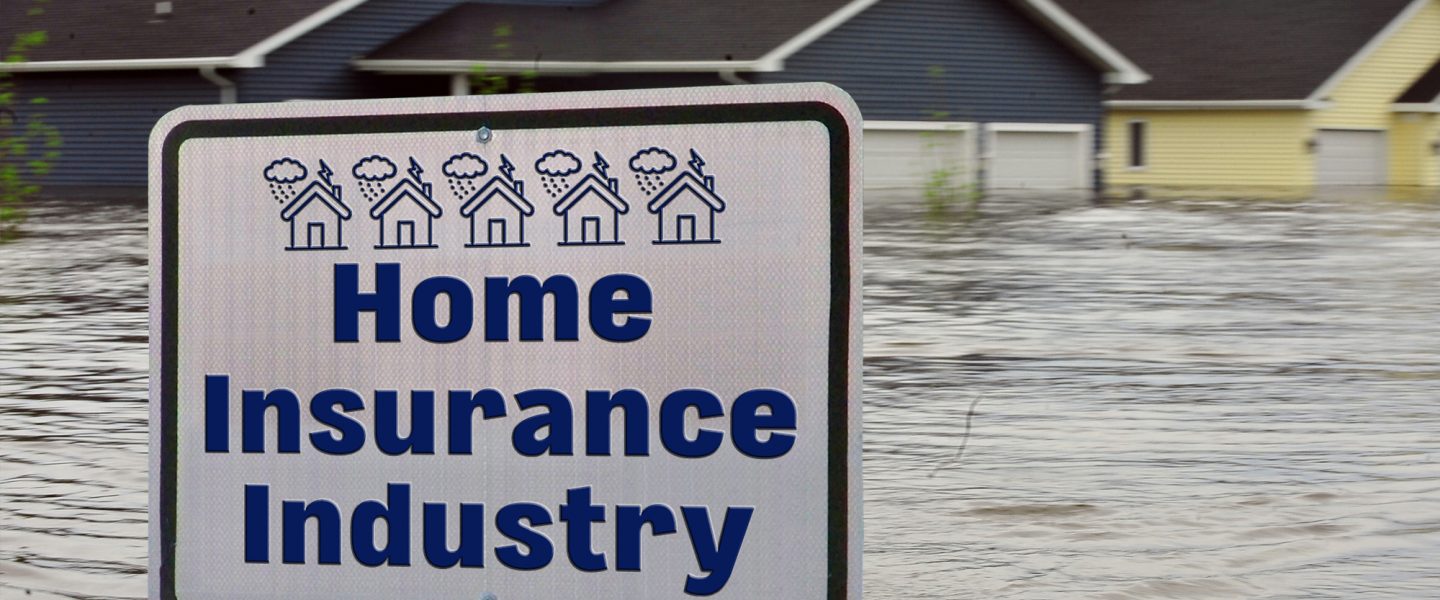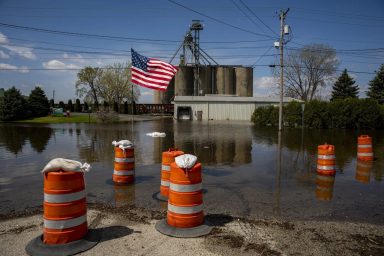What happens when a state becomes too disaster-prone to insure? Florida holds the answers.
|
Listen To This Story
|
Citing escalating wildfires as a major reason, California’s biggest home insurer, State Farm, recently announced it will no longer sell new homeowners insurance policies in the Golden State. So, what’s next for homeowners in California and other states where natural disasters are on the rise? We need to look no further than Florida, which has been near-uninsurable for years.
With increased hurricanes and flooding playing a large role in their choice to leave, major insurance companies had all but abandoned Florida by 2009. Since then, Floridians have seen premiums skyrocket and affordable options dwindle. By 2022, Florida had more homeowners without coverage per capita than any other state.
With big-name insurers also leaving California, a total of 60 million Americans are now finding it harder to get policies — and that number is expected to grow.
Record wildfires in Oregon and Colorado, violent storms in Texas, and coastal erosion swallowing North Carolina’s coastline have all led to reduced coverage and higher premiums for homeowners.
Confronted with the impacts of climate change, the insurance industry is facing “the hardest market in a generation,” according to a 2023 study by the American Property and Casualty Insurance Association.
There are two main reasons for this development: the cost associated with a sharp uptick in claims following natural disasters and the uncertainty surrounding future climate-related events.
When a state experiences a surge in natural disasters, insurance companies face substantial financial losses due to the increased volume of claims. As a short-term result, they seek to shore up their overall financial exposure, reducing coverage options or even withdrawing from certain regions.
In the long term, climate change introduces a new level of uncertainty, challenging traditional ways of assessing risk. Insurance companies rely on risk models and actuarial analysis to set premiums and determine where and what level of coverage will be available. But the rising severity and unpredictability of cataclysmic events make it difficult for them to calculate the potential losses they may face. So, they take a more conservative approach to determining the availability of coverage.
Other factors such as inflation, reconstruction costs, supply chain issues, and unchecked claims lawsuits are contributing to this development, putting further financial stress on insurance companies in the event of a disaster.
The common denominator in every case where this is happening is climate change, and since the natural disasters it brings show no signs of stopping, it’s reasonable to expect that this development will continue as the costs insurers face keep growing.
That means Florida’s current situation — where home insurance premiums are over three times the national average — could crop up in a host of states. To learn how this could unfold elsewhere, we can take a look at the historical buildup to what the Sunshine State is facing now, where homeowners have been forced to turn to more expensive alternatives.
“A lot of the reason local insurers are going belly-up ties back to the storms that they’re having to pay claims on. You’ve got tons of people living in high-risk areas, and when a big storm hits, suddenly [local insurers] have a lot of payouts, which can make them insolvent.” — Rob Moore, senior policy analyst at the Natural Resources Defense Council
After major insurance companies began leaving Florida in 1992 following Hurricane Andrew,
smaller regional insurers initially filled the resulting gap. However, these companies ultimately proved unable to weather the storm of property damage claims that took place over the coming decades. Florida’s broken claims litigation system, which has led to a glut of claims lawsuits and legal expenses for providers, also put a heavy strain on them.
Now, because of sudden, unforseen surges in claims, these regional insurers are going bankrupt and dropping policyholders. In 2023, 400,000 Florida homeowners were dropped when such companies went insolvent just as hurricane season began.
“A lot of the reason local insurers are going belly-up ties back to the storms that they’re having to pay claims on,” said Rob Moore, senior policy analyst at the Natural Resources Defense Council. “You’ve got tons of people living in high-risk areas, and when a big storm hits, suddenly [local insurers] have a lot of payouts, which can make them insolvent,” he said.
Even before Hurricane Ian, the third most costly weather disaster ever recorded, nine local insurance companies went broke in Florida. Then in 2022, when Ian struck the state, six Florida insurers declared insolvency.
Scrambling for remaining sources of coverage, homeowners are turning to Citizens, Florida’s “insurer of last resort.” The mass transition to Citizens has contributed greatly to the high cost of homeowner’s insurance in the Sunshine State.
“If you can’t get insurance from someone else at a price you can afford, you go to Citizens,” said Moore. “You don’t buy insurance from them because it’s cheaper, you buy it because you can’t find it elsewhere.”
In the early 2000s, many Florida homeowners could not find coverage on their own because their properties were in flood- and storm-heavy areas or exceedingly risky due to age or poor building materials. So, the Florida Legislature created a backstop insurer — Citizens — which will give anyone a policy no matter the risk.
State governments create last-resort insurers like Citizens to ensure that homeowners whose properties are so damage-prone that the private market will not insure them can still get coverage. Since they face such a high financial risk from claims filings and property damage, they balance this out by charging high premiums.
Traditionally, insurers-of-last-resort only account for a small portion of the homeowner’s insurance market, but Citizens is now Florida’s biggest property insurer. The rising tide of homeowner’s premiums and the absence of other options in Florida have made Citizens the most affordable choice for some, despite how expensive it is.
On average, a homeowner’s policy from Citizens costs $5,979 per year, almost three times the national average annual cost of $1,899.
Already pricey for homeowners, Citizens is facing financial trouble and raising premiums to compensate.
The company was unable to pay out all of the property damage claims that followed 2022’s Hurricane Ian. Rather than defaulting on homeowners, the company took out several hundred-million dollar loans, which it will repay by raising rates in the coming years.
Florida’s insurance commissioner has stated that, in a severe hurricane season, Citizens’ coffers could dry up again, leading to another premium hike.
When regional insurers went under in Florida, Louisianans who had policies with the same companies also found themselves without coverage. Now, the situation in the fellow Gulf Coast state bears a striking resemblance to the one in Florida: the cost of homeowner’s insurance is increasing dramatically.
In Louisiana, the home insurance crisis “has shown itself primarily in folks being unable to get coverage because of these failed companies out of Florida,” said Jim Donelon, Louisiana’s insurance commissioner.
This has driven homeowners to Louisiana’s own last-ditch insurer, Louisiana Citizens. The company now holds one of the largest shares of the homeowner’s insurance market in its state, and its policies also cost more than those on the private market.
“Our crisis is critical,” said Donelon. “The evidence of that, which speaks volumes, is that our market of last resort, Louisiana Citizens, has mushroomed to 130,000 policies,” he added.
Louisiana has seen more than enough of its own hurricanes to make insurers wary.
“We have been hit by named-storm landfalls four times more than Florida on a per-capita basis,” said Donelon.
After Rita and Ida, several Louisiana-based insurers went broke. Other companies have pulled out of the flood and storm-heavy areas along its coast.
The downfall of Florida-based insurance companies made homeowners lose coverage even in states that rarely face the same hurricane damage.
“These companies were doing a lot of business in other states, like North Carolina, Texas, and New York,” said Donelon.
Though the cause may be different than in the Gulf Coast, the West’s wildfires have created a similar situation for homeowners.
As climate change makes the air drier and California’s forests more combustible, many homeowners there are now finding themselves in expanding wildfire risk zones.

The Valley Fire destroyed hundreds of homes in Northern California in the late summer of 2015. Photo credit: Jeff Head / Flickr
This has led to a similar migration to the insurer of last resort seen in Florida. When a house is now more likely to go up in flames, insurers are less likely to offer policies, and so homeowners are forced to go to the state’s Fair Access to Insurance Requirements (FAIR) plan.
The FAIR plan, also a costly alternative, saw its policyholders double between 2018 and 2022.
The steady national increase in home-leveling disasters is putting a strain on another group: reinsurers. These companies offer insurance to insurers in case they are unable to pay out their claims in a widespread catastrophe, often acting as the last line of defense before bankruptcy. As climate change makes primary insurers more liable to file reinsurance claims, reinsurers are charging more for their policies to compensate.
Reinsurers tend to operate globally or nationally, taking on policies all over the world — and spreading the financial risk of catastrophic events across international borders. This means that insurance companies, particularly smaller ones who rely heavily on reinsurers in a worst-case scenario, are feeling the effects of far-off disasters as reinsurers raise rates.
Companies like Louisiana Citizens, which are almost completely dependent on the reinsurance market, could lose their final protection against being unable to pay out homeowners’ claims if reinsurers abandon them.
“We are at risk for wildfires in California, the record wildfires that happened two years ago in Australia, record flooding events in places like Germany,” said Donelon. “All of those natural disasters are contributing to the hardening of the reinsurance market.”
The underlying risk that insurers deal with is driven partly by real estate developers, who continue to build homes in flood and wildfire-prone regions. Insurance companies are sounding the alarm about the practice.
“The insurance industry is having a canary-in-the-coal-mine moment,” said Karen Collins, an insurance expert at APCIA specializing in environmental issues.
“We are in the unfortunate position of having to push back on these new developments,” she added. “We are simply reflecting the cost on the ground.”




